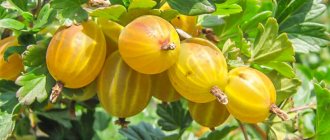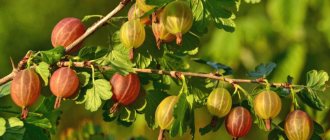Proper care of grapes in the fall not only increases the vine's resistance to frost, but is also the key to intensive development and health of plants in the spring, which is reflected in the size and quality of the berries next year.
The bulk of the work takes place in October, but you should start preparing grapes for winter in the middle zone already in the first half of September.
Planting grapes in autumn
When to plant grapes in the fall
Planting grape seedlings in autumn begins in the first weeks of October and ends with the onset of cold weather. The latest date is 8-10 days before the onset of the first frost. The justification for preferring autumn planting over spring planting is that at this time the buds are still dormant, and the root system is already developing, which is why the activity of young shoots begins in early spring of next year. Plus, if you just bought a seedling, you won't need to store it until spring.
The grapes are light-loving, so when choosing a place for them for many years, try to find an open area, protected from cold winds and drafts. It is not recommended to plant grapes near large trees, which will not only shade them from the sun, but will also not allow them to fully develop, sucking nutrients from the soil with their roots.
Grape seedlings in autumn
It is advisable to purchase seedlings from well-established sellers on the market, but this is not the only caveat. A high-quality seedling with an annual green shoot 40-50 cm high and a trunk thickness of 7-8 mm should have at least three light brown roots 10-15 cm long and at least 2-3 mm thick. The shoot should have well-ripened buds, and the roots should not be dry. Before planting, the shoots of the seedlings are shortened to 3-4 eyes, the roots at the upper nodes are cut off, and the remaining ones are lightly trimmed and placed in a heteroauxin solution for 12 hours.
How to plant grapes in autumn
Holes for grapes are dug in advance, measuring 50x50x60, a drainage layer of crushed stone or broken brick 5-7 cm thick is poured into them, thick paper is laid on top, a drainage pipe is installed under the wall of the hole, through which the bush is subsequently fed and watered. Then pour a couple of buckets of fertile soil, a glass of nitroammophoska, a handful of ash, a bucket of humus into the hole, mix everything thoroughly and then fill the hole to the top with earth. Fill the hole only with the top, fertile layer of soil; it is better not to use the bottom layer.
Now you need to water the hole generously several times, and you will see that the soil in it will settle. Let the pit stand for a couple of weeks after settling. You can’t plant grapes right away, because as the soil settles, it will pull the seedling deeper and tear its roots. It is best to start preparing the hole for autumn planting of grapes in early August. If you are planting several seedlings, the distance between the holes should be at least a meter.
During planting, a bucket of soil is poured into the center of the hole, a seedling is placed on it, the roots are straightened and the hole is filled with fertile soil until it grows. Short seedlings are placed vertically on a mound, and those taller than 25 cm are placed obliquely in the hole - the main thing is that the heel is at a depth of 50 cm, and the base of the growth is at a depth of 25 cm. After filling the hole, compact the soil and water the seedling generously with two or three buckets of water, and then cover it with a cut-off plastic bottle.
Pruning a grape bush in autumn
Pruning bushes is another item on our list of autumn care that must be carried out in order to spend a minimum amount of time in the spring restoring the health of the plant, or planting the area with new canes.
Grapevine segments
After carrying out this procedure, the gardener can observe the following positive effects:
- a significantly richer harvest the next year, compared to vines unpruned in the fall;
- rejuvenation of the bush and its growth proceeding with renewed vigor;
- rapid ripening of the crop due to the fact that the movement of juice in young vines is much more intense;
- increased resistance to severe frosts;
- easier bush care;
- stopping at the stage of development of diseases, damage from garden pests.
This procedure can be started only after the grapes have entered a state of winter “hibernation”, that is, several weeks after the plant has lost all its foliage. Before the specified time period, photosynthesis is still occurring inside the plant, which is not recommended to be interrupted.
You cannot prune grapes thoughtlessly, otherwise the plant will simply die
When to prune depends on the climatic conditions characteristic of the region where you live. So, the closer the frost, the sooner the required procedure needs to be carried out, and vice versa. So, the standard time for circumcision is the end of September.
If you hesitate and don’t start pruning before the first frost, then when you come to your senses and start the procedure, you may accidentally break off the vines, weakened by the cold, and in absolutely the wrong place where you need it.
During bush pruning, removal occurs in stages. Let's look at exactly how in the table below.
Table 1. Stages of autumn pruning of grapes
| First stage | Second phase |
First of all, the winegrower who starts pruning must remove branches that:
| At the second stage, when the plant is cleared of pests and diseases, the shoots are removed in such a way as to correctly form the shape of the grape tree. You need to understand that not only healthy vines are left to grow on the bush, but also young shoots, thanks to which new segments of the bush will form. |
By following the rules of pruning, you will not only help the plant survive the winter, but also give it the strength to form a more abundant harvest next year.
There are several important pruning rules that need to be taken into account so as not to harm lovingly cultivated plants. Let's look at them.
1. Do not remove the lower two buds from the vines, as they have not yet developed to the desired state at the time of the onset of autumn.
2. With the onset of September, by about the 10th, it is necessary to have time to cut off all the side branches on the old grape vines, located at a level of approximately 60 centimeters from the ground.
3. For young green shoots, the top of which is located approximately 30 centimeters from the ground, it is necessary to cut off only the upper part, that is, no more than 15% of the total length of the lash. The side shoots extending from them must be trimmed, keeping no more than two leaves.
4. In October, the plant will begin to set fruit links. In order for them to develop correctly in the future, it is necessary to find strong shoots that have grown to a level of approximately 60 centimeters, and cut off the lower one so that only 3 eyes remain on it. We also cut off the top one, leaving 6 eyes on it.
How to trim grape sleeves correctly
5. With the arrival of September 15th:
- all young shoots that have reached a length of 20 centimeters at the time are cut off;
- lashes that have grown to 30 centimeters are shortened by 10% of their original size.
6. For branches that have been alive for a whole year, all protruding shoots are cut off, and only those that are located at right angles relative to them are preserved.
7. The dried top of the bush is also removed.
After you complete the entire procedure of pruning the plant, you will need to purchase a garden varnish - a resinous substance that protects plants from rotting, and coat all cut areas on the plant with it.
Garden var is a universal remedy in the fight against any damage to the bark
Please note: you should not cut out all the young shoots that have formed at the bush, since in the spring, if the main shoots are damaged by low temperatures, it is the fresh stems that will take on the role of a source of cultivated fruits.
Prices for garden varnish
garden var
Autumn pruning of grapes
The timing of pruning grapes depends on the weather and climatic conditions in your region. The optimal time is when the first frost has passed, the vine has stopped growing wood, and its leaves have already fallen off.
To begin, remove the grapes from the trellis, remove the remaining mustaches, leaves, and stepsons. Trim off all unripe shoots. Then remove all short, thin (less than 5 mm in diameter), broken and diseased shoots.
Cut out the fruit shoots that bear fruit. If after this there are many annual shoots left, remove those that are not needed next year (growing on a trunk, from the ground, etc.). Trim the remaining vines, leaving 15 eyes on each.
Top dressing
A grape bush that is depleted of fruiting does not have sufficient resistance to cold and can freeze out during the winter. Conditions favorable for the development of fungi may form under the shelter (for example, due to thaws), and in this case, the health of the plants by spring will depend on their immunity, so sending weakened grapes to the shelter is dangerous.
To avoid negative consequences, the grapes must receive additional feeding in September. It is necessary to replenish the supply of nutrients, primarily potassium and phosphorus, as well as calcium, magnesium, copper, iron, manganese, zinc and boron. During this period, it is not recommended to give nitrogen, since the substance provokes the growth of green mass, while the grapes should go into a dormant phase. Only young plants do not need feeding, since the fertilizers added to the hole when planting should be enough for 3-4 years.
Phosphorus and potassium promote the aging of wood. Potassium, in addition, increases plant immunity and resistance to negative temperatures.
Fertilizer can be applied in liquid form, dry method or by spraying. For watering, it is necessary to dig a 10 cm deep groove around the bush at a distance of 40 cm so that the fertilizer does not spread, wetting the surface layer of soil, but reaches the roots. As a liquid fertilizer in the fall, you should choose one of the following options:
- 30-40 g of superphosphate and 20-30 g of potassium sulfate per 10 liters of water;
- 20-40 g of potassium monophosphate for the same volume;
- extract from 200-300 g of wood ash per 1 liter.
Microelements can be added to the nutrient solution or applied foliar. Spraying should be carried out in the evening: at this time the absorbency of the leaves is higher than during the day, and there is no bright sun that can burn wet greenery. For foliar feeding, the concentration of the substance must be reduced by 3 times compared to the volume calculated for irrigation:
- magnesium sulfate – 1 g per 10 liters;
- manganese sulfate – 2 g;
- boric acid – 1-2 g;
- zinc sulfate – 2 g.
The bush will receive copper and iron in sufficient quantities if treatment with copper or iron sulfate is used as a preventive measure for fungal diseases. Additional spraying should not be carried out to avoid plant poisoning.
If a foliar method is used to feed microelements, phosphorus-potassium fertilizer can be given in dry form. To do this, it is enough to embed 300 g of ash into the soil when digging or put 10-15 kg of rotted manure or compost in a furrow 20-25 cm deep, dug around the bush, and then water the plant generously. The fertilizer ditch should be made at a distance of at least 40-50 cm from the growing point. You can also apply manure mixed with wood ash in the form of mulch. Only well-rotted organic matter is suitable for autumn feeding, otherwise the grapes will receive an excess amount of nitrogen.
How to properly care for grapes (with video)
To avoid negative phenomena, soil mulching is used. It is good to use organic materials as mulch: peat, compost, grass clippings. They line the entire area under grape plantings or just around the bushes. How to properly care for grapes using mulch? The thickness of the mulch layer should be about 10 cm. On peat soils, it is very good to use sanding - mulching with a thick, up to 10 cm, layer of sand. This technique not only improves the living conditions of the grape root system, but also prevents the growth of weeds and mitigates the harmful effects of frost.
Around fruiting grape bushes, you can use a green manure soil management system. The use of green manure improves the properties of the soil, enriches it with organic matter, prevents erosion, and suppresses the growth of weeds.
Green manure is sown around the bushes after the grapes have finished flowering. In the Non-Black Earth Region you can use lupine, vetch, phacelia, mustard, etc. During flowering, the green mass is mowed, crushed and embedded in the soil. However, if there is a strong spread of diseases, it is better to abandon this system, since additional crops impair air circulation and reduce ventilation.
The video “Growing and caring for grapes” shows how all of the above agrotechnical techniques are performed:
Treatment of grapes against diseases
A very important point in autumn grape care is treating (spraying) the vines with a fungicide before covering for the winter. The procedure will destroy pathogens of dangerous fungal diseases that may awaken in the spring, and also minimize the risk of mold development (during shelter).
The optimal time for treating vines in the fall is when all the leaves have fallen and the buds have completely closed, not earlier!
Iron sulfate is most often used as a fungicide. The dosage when preparing the solution depends on the condition of the vine:
- if it is a young bush, then it is better to use a 1% solution (100 grams of iron sulfate per 10 liters of water);
- if an adult shrub has not previously been exposed to diseases, then a 3% solution (300 g per 10 liters of water);
- if an adult shrub has previously suffered from fungal diseases, then you need to spray it with a 5% solution (500 g per 10 liters of water).
When treating grapes with a fungicide, do not forget to spray the soil around the plant to accurately eliminate all pathogens.
Sheltering grapes for the winter
After pruning and processing, bend the shoots as low as possible to the ground along the row and secure with pins so that the bush lies compactly.
Covering with soil
Covering with soil is the simplest and most effective method of insulation. Cover the grape bush secured with pins with soil 10-15 cm thick, and in late November - early December increase the layer to 25-30 cm. Under such a “blanket” the vine will not freeze at –15-20°C. And when the weather changes, the temperature in the shelter will not change too sharply.
Covering with straw or sawdust
You will need approximately 5-10 kg of straw or sawdust for covering per 1 linear meter of trellis. First, spread dry grass in a layer of 15-20 cm, and after about a month, increase the thickness of the straw “blanket” to 30-40 cm.
It’s easy to cover grapes with straw or sawdust, but they need to be trampled down immediately so that they don’t get blown away by the wind. In spring, such a shelter can be left under the bush as mulch and organic fertilizing. But if you use sawdust, keep in mind that soil bacteria consume a large amount of nitrogen to decompose it. Therefore, at the beginning of the new season, be sure to add an increased dose of nitrogen fertilizers to the soil under the grapes.
Shelter with spruce branches
Rodents do not like spruce spruce branches, and fungal diseases are not scary for them either. The layer of branches for covering should be about 30-40 cm thick.
In spring, fallen pine needles will become a wonderful organic fertilizer.
Combined shelter
Covering material can be combined. Here are some options:
- Layer of spruce branches (5-10 cm), cover with soil, peat or straw on top.
- Soil (10-15 cm), and a little later - straw, sawdust or fallen leaves in a layer of 30 cm.
- Straw (10-15 cm), on top - earth or peat.
It is not recommended to cover grapes with film, roofing felt or other material that does not allow air and moisture to pass through. With temperature changes (especially sudden ones), damping out of the eyes may occur.
Snow cover
Snow cover is the best mulch that nature has created. In winter, when snow falls, throw it on the vine. Even if you grow varieties that do not require shelter for the winter (Minsky pink, Violet August, hybrids 8-17, etc.), it is also better to insulate them. This way you are guaranteed to get a full harvest next year.
Options for covering bushes
Cover the grape bushes with different materials. Some are suitable for regions with any climate, others for southern regions with warm winters.
Lapnik
If there is a coniferous forest near the area where the grapes grow, then pine and spruce branches will be an excellent shelter for the plant. The vines are covered with spruce branches on top, the layer thickness is 30-40 cm.
This method of shelter has many advantages:
- rodents do not live in spruce branches;
- it is breathable;
- no mold or mildew;
- The procedure requires little time.
Straw
Straw is an environmentally friendly, breathable shelter. The grapes are covered with straw twice.
The vines are laid on boards and covered with a layer of straw 20-25 cm thick. The same layer is laid after 2-3 weeks.
To prevent the straw from being blown away by the wind, it is secured with arcs or spunbond.
The straw is also covered with snow on top. Straw has one significant disadvantage - rodents often live in it.
Snow
This type of shelter is convenient in regions where heavy snow falls. The vines are first laid on plywood or boards and secured with metal staples.
The height of the snow cover should be at least 50 cm, so snow is added during the winter. To prevent the snow from being blown away by the wind, it is lightly compacted.
Snow covering is one of the easiest and fastest methods, but it also has disadvantages:
- if severe frosts (up to -10°C) occur before snow falls, the plant may die;
- winter thaws lead to snow melting and shelter disappearing;
- alternating thaws and frosts lead to the death of the plant.
Earth
The grapes are covered with earth or turf when frost sets in. First, a layer 10 cm thick is poured, and after 3 weeks another similar layer is poured.
With this method, containers with dry soil are prepared in advance. The disadvantage is the possible freezing of the ground cover.
Ruberoid
This material is used in regions with mild winters where little snow falls.
The vines are wrapped in burlap and placed in grooves prepared on the ground. Then roofing felt is laid on top. Since it is airtight, it is periodically removed for ventilation.
Important! If grapes grow on sandy soil, you cannot dig them in - such soils freeze in winter.
Film
An effective way to cover grapes in regions with mild winters. The plant is laid on the ground and iron arches are placed on top without securing them. The arcs are covered with film and sprinkled with earth along the edges. On one side, gaps are left for air access. With the onset of cold weather, the cracks are securely closed.
Pre-winter watering
Autumn care for grapes in September in the middle zone involves continuing watering as usual, with the exception of periods of rainy weather. Moisture deficiency prevents wood from preparing for the winter season.
It is especially important to maintain moisture if the grapes grow on sandy or sandy loam soil. In this case, you need to water the vineyard often, in small portions, but plants on clay soil or black soil need less frequent but abundant irrigation.
After the leaves have fallen off and the main pruning has been carried out, but before the soil has time to freeze, you need to do water-recharging watering. Water should be poured into trenches 10 cm deep around the bush. On average, you need to give 5 full buckets of water for each plant. Old and growing vines will need up to 10 buckets, young plants will need 10-30 liters. Sandy soil requires an increase in the watering dose to 6 buckets (relative to the average), and clay soil reduces it to 2.5-3 buckets.
How to properly water grapes
Grapes, like other vines, due to the rapid growth of shoots, require a fairly high water consumption. In the middle zone, a fairly large amount of precipitation falls, but its distribution throughout the year often does not coincide with the maximum water needs of grapes. And weather conditions can be unpredictable. Therefore, the possibility of watering when caring for grapes should always be provided.
These plants have two periods of highest water consumption. The first is associated with intensive growth of shoots, and the second with the growth of berries. And if the growth of shoots occurs at the end of May, when the soil still has a sufficient supply of moisture, then the growth of berries occurs in mid-summer. At this time, dry weather often sets in in the middle zone. Thus, during the growing season, 2-3 waterings of fruit-bearing grape bushes may be necessary. The first is at the end of May, it is carried out before flowering in the case of little snowy winter and hot, dry spring. A second and third watering may be needed after flowering, as the berries increase in size in dry summer conditions. When the crop begins to ripen, watering is stopped, since an increase in humidity during this period leads to a decrease in sugar content.
In addition to vegetation irrigation, autumn water-recharging irrigation can be carried out in the vineyard. It is necessary in case of insufficient rainfall after harvesting. If the autumn turns out to be dry, then, on the one hand, it becomes difficult to prepare plants for winter, and on the other hand, dry soil easily freezes at the first drop in temperature below zero.
For grapes, in the first year of life after planting, the soil in the root zone must be constantly kept moist, but not in a waterlogged state. The survival rate of seedlings largely depends on this.
How should grapes be watered so that the plant actively develops and bears fruit well? Irrigation water should reach the depth of the roots. Therefore, 3-4 buckets of water must be poured under each fruit-bearing plant in one watering.
Before watering grapes, well or tap water must be collected in containers in advance so that it can settle and warm up to air temperature. With proper care of grapes, watering is carried out in the morning or evening hours.
Loosening the soil after watering improves aeration and prevents unproductive moisture consumption. Mulching the soil gives good results. The next watering is carried out only after the top layer of soil has dried well. Often, to ensure access of water to deep layers of soil when planting bushes, perforated pipes are installed. Subsequently, irrigation water is poured into these pipes. On the one hand, this allows the root zone to be moistened, and on the other hand, the surface layer of soil remains dry, which prevents the growth of weeds and the development of dew roots. For the winter, the pipe opening is closed.
In the process of caring for grapes, do not forget that frequent watering with small amounts of water has a number of negative consequences: the plant still experiences a moisture deficit, the aeration of the deep layers of the soil is disrupted, the roots begin to develop the surface layer of soil, and as a result, the stability of the bushes decreases.
Watch the video “How to care for grapes” to better understand how to water this plant:
Fertilizing
By the time the harvest ripens, the grapevine gives all its strength, so nutrients are added in the fall. Timely feeding helps preserve flower buds and restore the plant's strength.
One of the most nutritious and safest remedies is humus. Rotted leaves are collected around the plant, mixed with turf, sprinkled around the bushes and dug up. Potassium fertilizers are added on top.
When planting new seedlings in the autumn, humus is first added to the planting hole.
Grape bushes love calcareous soils. Lime is quickly washed out of the soil, so it is applied regularly both in spring and autumn.
The vineyard is also fed with aqueous solutions of fertilizers. Take 10 g of aqueous extract of potassium fertilizers, 20 g of phosphorus fertilizers and dissolve in 10 liters of water. This mixture is poured into the soil around the bushes to a depth of 25 cm.
It is useful to add a solution of microelements to the irrigation mixture - iodine, potassium permanganate, boric acid, ammonium molybdate.
Wood ash is also used for feeding. Take 200 g per 1 m², scatter it around the bushes and lightly dig it up.
Nitrogen fertilizers are not applied in the autumn, as they promote the growth of green mass, and this leads to freezing of the plant.
If you do not fertilize grapes in the fall, spring fertilizing will not be able to compensate for the deficiency of nutrients in the soil.
Preparing grapes for winter
Preparation of grape vines for winter begins from the moment of harvest in September and is carried out according to the following plan:
- Watering the bushes, from 60 to 100 liters of water for each bush;
- If necessary, catarrhosis;
- Fertilizing the soil with rotted manure and compost;
- Autumn pruning of vines;
- Treatment of the vine and the soil underneath it to prevent fungal diseases;
- Tilling the soil under bushes against wintering insects;
- Removing the vines from the trellis and bending them to the ground;
- Sheltering bushes for the winter in the middle zone is usually done by covering the vines pressed to the ground with old polypropylene bags and sprinkling them with 20-25 centimeters of soil on top. We described a more detailed description of these rules and how to properly prepare grapes for wintering in this article above.
conclusions
To successfully winter grapes, follow a few simple rules:
- Autumn preparation, including not only pruning, but also watering, fertilizing, and treating against possible fungal infections.
- Shelter in winter in the Urals, Siberia and other regions. The more carefully and better the work is done, the easier the vineyard will withstand the cold. Do not forget about ventilation and air exchange in the ridges.
- During the winter period itself, care comes down to monitoring the condition of the vineyards and making any adjustments to improve the condition.
- After winter, the vine is opened, but allowed to breathe for several days or weeks, get stronger and adapt. After this, the film is finally removed.
Preparing grapes for winter is a very important stage in their cultivation, since the safety of the plant and the next year’s harvest will depend on this.











